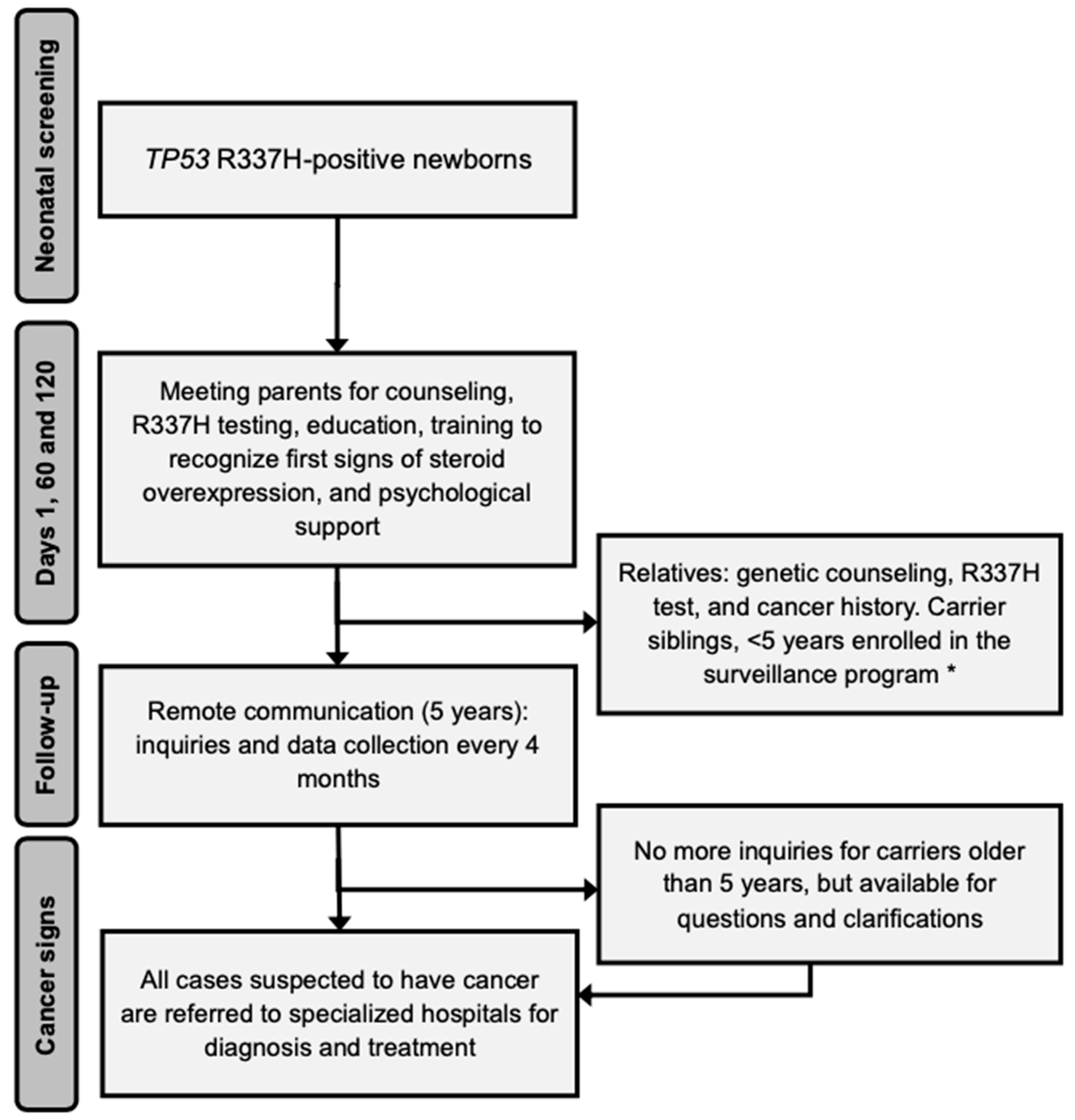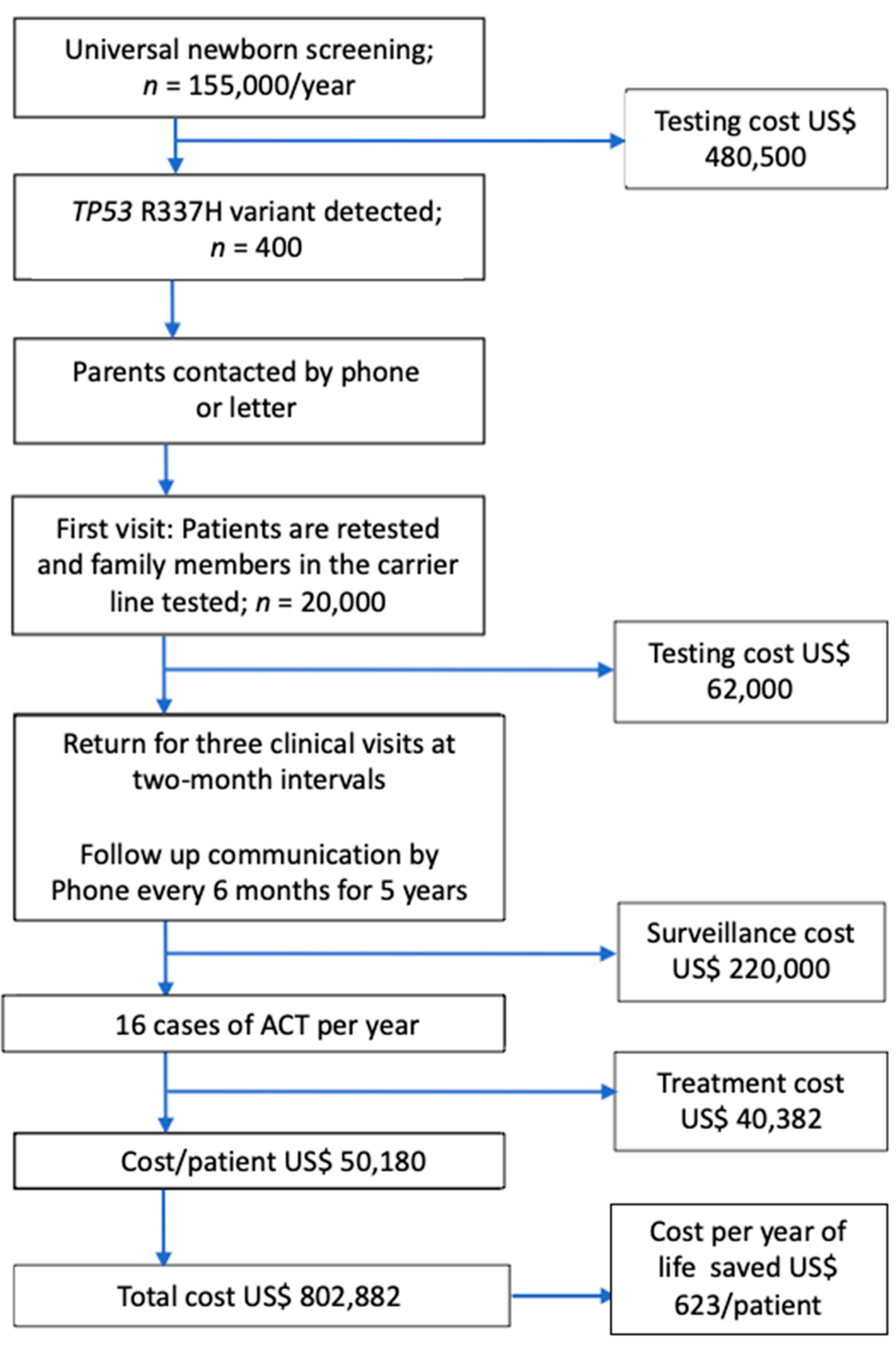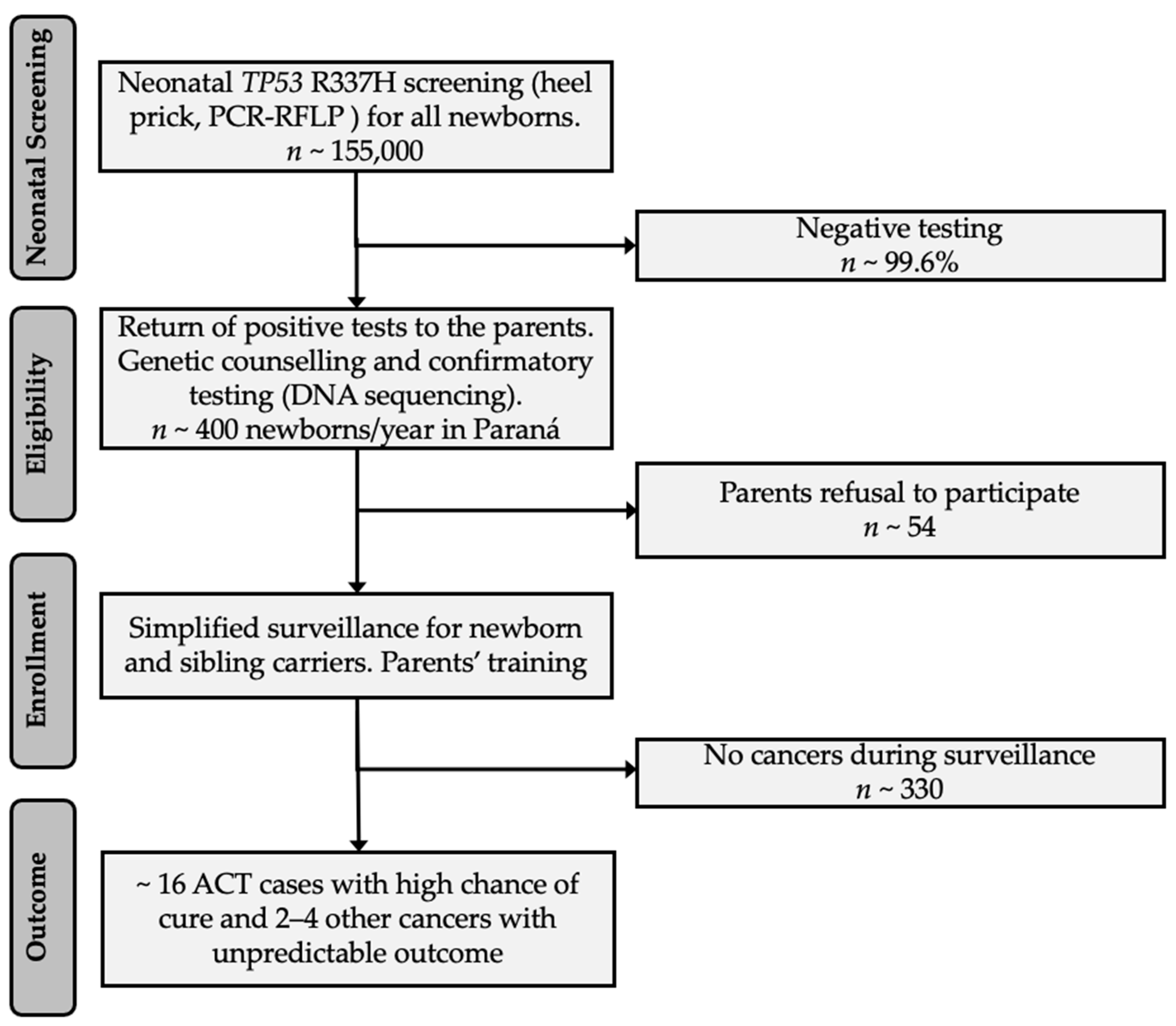Newborn Screening for the Detection of the TP53 R337H Variant and Surveillance for Early Diagnosis of Pediatric Adrenocortical Tumors: Lessons Learned and Way Forward
Abstract
Simple Summary
Abstract
1. Introduction
2. Materials and Methods
2.1. Subjects
2.2. Newborn Screening and Surveillance Database of Pele Pequeno Principe Research Institute/Pequeno Principe Hospital
2.3. Costs
2.4. Statistical Analysis
3. Results
3.1. Single Hospital Cohort vs. Newborn Screening and Surveillance Cohorts
3.2. DATASUS Registry Cohort and Neonatal Screening and Surveillance Costs
4. Discussion
5. Conclusions
Supplementary Materials
Author Contributions
Funding
Institutional Review Board Statement
Informed Consent Statement
Data Availability Statement
Acknowledgments
Conflicts of Interest
References
- Custódio, G.; Parise, G.A.; Kiesel Filho, N.; Komechen, H.; Sabbaga, C.C.; Rosati, R.; Grisa, L.; Parise, I.Z.; Pianovski, M.A.; Fiori, C.M.; et al. Impact of Neonatal Screening and Surveillance for the TP53 R337H Mutation on Early Detection of Childhood Adrenocortical Tumors. J. Clin. Oncol. 2013, 31, 2619–2626. [Google Scholar] [CrossRef]
- Costa, T.E.J.; Gerber, V.K.Q.; Ibañez, H.C.; Melanda, V.S.; Parise, I.Z.S.; Watanabe, F.M.; Pianovski, M.A.D.; Fiori, C.M.C.M.; Fabro, A.L.M.R.; Silva, D.B.D.; et al. Penetrance of the TP53 R337H Mutation and Pediatric Adrenocortical Carcinoma Incidence Associated with Environmental Influences in a 12-Year Observational Cohort in Southern Brazil. Cancers 2019, 11, 1804. [Google Scholar] [CrossRef]
- Ribeiro, R.C.; Sandrini, F.; Figueiredo, B.; Zambetti, G.P.; Michalkiewicz, E.; Lafferty, A.R.; DeLacerda, L.; Rabin, M.; Cadwell, C.; Sampaio, G.; et al. An Inherited p53 Mutation That Contributes in a Tissue-Specific Manner to Pediatric Adrenal Cortical carcinoma 2001. Proc. Natl. Acad. Sci. USA 2001, 98, 9330–9335. [Google Scholar] [CrossRef]
- Kerkhofs, T.M.; Ettaieb, M.H.; Verhoeven, R.H.; Kaspers, G.J.; Tissing, W.J.; Loeffen, J.; Van den Heuvel-Eibrink, M.M.; De Krijger, R.R.; Haak, H.R. Adrenocortical carcinoma in children: First population-based clinicopathological study with long-term follow-up. Oncol. Rep. 2014, 32, 2836–2844. [Google Scholar] [CrossRef]
- McAteer, J.P.; Huaco, J.A.; Gow, K.W. Predictors of survival in pediatric adrenocortical carcinoma: A Surveillance, Epidemiology, and End Results (SEER) program study. J. Pediatr. Surg. 2013, 48, 1025–1031. [Google Scholar] [CrossRef]
- Pinto, E.M.; Chen, X.; Easton, J.; Finkelstein, D.; Liu, Z.; Pounds, S.; Rodriguez-Galindo, C.; Lund, T.C.; Mardis, E.R.; Wilson, R.K.; et al. Genomic landscape of pediatric adrenocortical tumors. Nat. Commun. 2015, 6, 6302. [Google Scholar] [CrossRef]
- Custodio, G.; Taques, G.R.; Figueiredo, B.C.; Gugelmin, E.S.; Oliveira Figueiredo, M.M.; Watanabe, F.; Pontarolo, R.; Lalli, E.; Torres, L.F. Increased Incidence of Choroid Plexus Carcinoma due to the Germline TP53 R337H Mutation in Southern Brazil. PLoS ONE 2011, 6, e18015. [Google Scholar] [CrossRef]
- Howlader, N.; Noone, A.M.; Krapcho, M.; Brest, A.; Yu, M.; Ruhl, J.; Tatalovich, Z.; Mariotto, A.; Lewis, D.R.; Chen, H.S.; et al. SEER Cancer Statistics Review, 1975–2017; National Cancer Institute: Bethesda, MD, USA, 2020. [Google Scholar]
- Seidinger, A.L.; Mastellaro, M.J.; Paschoal Fortes, F.; Godoy Assumpção, J.; Aparecida Cardinalli, I.; Aparecida Ganazza, M.; Correa Ribeiro, R.; Brandalise, S.R.; Dos Santos Aguiar, S.; Yunes, J.A. Association of the Highly Prevalent TP53 R337H Mutation with Pediatric Choroid Plexus Carcinoma and Osteosarcoma in Southeast Brazil. Cancer 2011, 117, 2228–2235. [Google Scholar] [CrossRef]
- Mastellaro, M.J.; Seidinger, A.L.; Kang, G.; Abrahão, R.; Miranda, E.C.M.; Pounds, S.B.; Cardinalli, I.A.; Aguiar, S.S.; Figueiredo, B.C.; Rodriguez-Galindo, C.; et al. Contribution of the TP53 R337H mutation to the cancer burden in southern Brazil: Insights from the study of 55 families of children with adrenocortical tumors. Cancer 2017, 123, 3150–3158. [Google Scholar] [CrossRef]
- Kumar, P.; Gill, R.M.; Phelps, A.; Tulpule, A.; Matthay, K.; Nicolaides, T. Surveillance Screening in Li-Fraumeni Syndrome: Raising Awareness of False Positives. Cureus 2018, 10, e2527. [Google Scholar] [CrossRef]
- Lammens, C.R.; Aaronson, N.K.; Wagner, A.; Sijmons, R.H.; Ausems, M.G.; Vriends, A.H.; Ruijs, M.W.; van Os, T.A.; Spruijt, L.; Gómez García, E.B.; et al. Genetic testing in Li-Fraumeni syndrome: Uptake and psychosocial consequences. J. Clin. Oncol. 2010, 28, 3008–3014. [Google Scholar] [CrossRef]
- Marigo, C.; Muller, H.; Davies, J.N.P. Survey of cancer in children admitted to a Brazilian charity hospital. Natl. Cancer Inst. 1969, 43, 1231–1240. [Google Scholar] [CrossRef]
- Caminha, I.P. Prevalence of TP53 Germline Mutation p. R337H in the Metropolitan Region of Campinas and Surrounding Cities. Ph.D. Thesis, Universidade Estadual de Campinas, Campinas, Brazil, 2015. [Google Scholar]
- Rodriguez-Galindo, C.; Figueiredo, B.C.; Zambetti, G.P.; Ribeiro, R.C. Biology, Clinical Characteristics, and Management of Adrenocortical Tumors in Children. Pediatr. Blood Cancer 2005, 45, 265–273. [Google Scholar] [CrossRef]
- Berruti, A.; Terzolo, M.; Pia, A.; Angeli, A.; Dogliotti, L. Mitotane associated with etoposide, doxorubicin, and cisplatin in the treatment of advanced adrenocortical carcinoma. Italian Group for the Study of Adrenal Cancer. Cancer 1998, 83, 2194–2200. [Google Scholar] [CrossRef]
- Zancanella, P.; Pianovski, M.A.; Oliveira, B.H.; Ferman, S.; Piovezan, G.C.; Lichtvan, L.L.; Voss, S.Z.; Stinghen, S.T.; Callefe, L.G.; Parise, G.A.; et al. Mitotane associated with cisplatin, etoposide, and doxorubicin in advanced childhood adrenocortical carcinoma: Mitotane monitoring and tumor regression. J. Pediatr. Hematol. Oncol. 2006, 28, 513–524. [Google Scholar] [CrossRef] [PubMed]
- Rodriguez-Galindo, C.; Krailo, M.D.; Pinto, E.M.; Pashankar, F.; Weldon, C.B.; Huang, L.; Caran, E.M.; Hicks, J.; McCarville, M.B.; Malkin, D.; et al. Treatment of Pediatric Adrenocortical Carcinoma With Surgery, Retroperitoneal Lymph Node Dissection, and Chemotherapy: The Children’s Oncology Group ARAR0332 Protocol. J. Clin. Oncol. 2021, 39, 2463–2473. [Google Scholar] [CrossRef]
- Ministry of Health. Management System for Procedures, Drugs and Orthoses, Prostheses, and Special Materials of SUS 2020. Available online: http://sigtap.datasus.gov.br/tabela-unificada/app/sec/inicio.jsp (accessed on 3 October 2020).
- National Health Surveillance Agency (ANVISA). 2020. Available online: https://www.gov.br/anvisa/pt-br/assuntos/medicamentos/cmed/precos/arquivos/lista-conformidade-2020-09 (accessed on 3 June 2021).
- Kassambara, A.; Kosinski, M.; Biecek, P.; Fabian, S. Survminer: Drawing Survival Curves Using ‘ggplot2’. R Package Version 0.4.9. 2021. Available online: https://CRAN.R-project.org/package=survminer (accessed on 4 June 2021).
- Lenth, R.V. Emmeans: Estimated Marginal Means, aka Least-Squares Means. R Package Version 1.5.0. 2020. Available online: https://CRAN.R-project.org/package=emmeans (accessed on 4 June 2021).
- R Core Team. R: A Language and Environment for Statistical Computing; R Foundation for Statistical Computing: Vienna, Austria, 2021. [Google Scholar]
- Michalkiewicz, E.; Sandrini, R.; Figueiredo, B.; Miranda, E.C.; Caran, E.; Oliveira-Filho, A.G.; Marques, R.; Pianovski, M.A.; Lacerda, L.; Cristofani, L.M.; et al. Clinical and Outcome Characteristics of Children with Adrenocortical Tumors: A Report from the International Pediatric Adrenocortical Tumor Registry. J. Clin. Oncol. 2004, 22, 838–845. [Google Scholar] [CrossRef]
- Doghman, M.; Karpova, T.; Rodrigues, G.A.; Arhatte, M.; De Moura, J.; Cavalli, L.R.; Virolle, V.; Barbry, P.; Zambetti, G.P.; Figueiredo, B.C.; et al. Increased Steroidogenic factor-1 Dosage Triggers Adrenocortical Cell Proliferation and Cancer. Mol. Endocrinol. 2007, 21, 2968–2987. [Google Scholar] [CrossRef]
- Rosati, R.; Cerrato, F.; Doghman, M.; Pianovski, M.A.; Parise, G.A.; Custódio, G.; Zambetti, G.P.; Ribeiro, R.C.; Riccio, A.; Figueiredo, B.C.; et al. High Frequency of Loss of Heterozygosity at 11p15 and IGF2 Overexpression Are Not Related to Clinical Outcome in Childhood Adrenocortical Tumors Positive for the R337H TP53 Mutation. Cancer Genet. Cytogenet. 2008, 186, 19–24. [Google Scholar] [CrossRef] [PubMed]
- Leal, L.F.; Mermejo, L.M.; Ramalho, L.Z.; Martinelli, C.E., Jr.; Yunes, J.A.; Seidinger, A.L.; Mastellaro, M.J.; Cardinalli, I.A.; Brandalise, S.R.; Moreira, A.C.; et al. Wnt/Beta-Catenin Pathway Deregulation in Childhood Adrenocortical Tumors. J. Clin. Endocrinol. Metab. 2011, 96, 3106–3114. [Google Scholar] [CrossRef]
- Letouzé, E.; Rosati, R.; Komechen, H.; Doghman, M.; Marisa, L.; Flück, C.; de Krijger, R.R.; van Noesel, M.M.; Mas, J.C.; Pianovski, M.A.; et al. SNP array profiling of childhood adrenocortical tumors reveals distinct pathways of tumorigenesis and highlights candidate driver genes. J. Clin. Endocrinol. Metab. 2012, 97, 1284–1293. [Google Scholar] [CrossRef] [PubMed]
- Parise, I.Z.S.; Parise, G.A.; Noronha, L.; Surakhy, M.; Woiski, T.D.; Silva, D.B.; Costa, T.E.B.; Del-Valle, M.H.C.P.; Komechen, H.; Rosati, R.; et al. The Prognostic Role of CD8+ T Lymphocytes in Childhood Adrenocortical Carcinomas Compared to Ki-67, PD-1, PD-L1, and the Weiss Score. Cancers 2019, 11, 1730. [Google Scholar] [CrossRef]
- Sandrini, R.; Raul, R.; DeLacerda, L. Childhood Adrenocortical Tumors. J. Clin. Endocrinol. Metab. 1997, 82, 2027–2031. [Google Scholar] [CrossRef] [PubMed][Green Version]
- Figueiredo, B.C.; Sandrini, R.; Zambetti, G.P.; Pereira, R.M.; Cheng, C.; Liu, W.; Lacerda, L.; Pianovski, M.A.; Michalkiewicz, E.; Jenkins, J.; et al. Penetrance of Adrenocortical Tumours Associated with the Germline TP53 R337H Mutation. J. Med. Genet. 2006, 43, 91–96. [Google Scholar] [CrossRef] [PubMed]
- Mai, P.L.; Best, A.F.; Peters, J.A.; DeCastro, R.; Khincha, P.P.; Loud, J.T.; Bremer, R.C.; Rosenberg, P.S.; Savage, S.A. Risks of first and subsequent cancers among TP53 mutation-carriers in the NCI LFS cohort. Cancer 2016, 122, 3673–3681. [Google Scholar] [CrossRef] [PubMed]
- Wasserman, J.D.; Novokmet, A.; Eichler-Jonsson, C.; Ribeiro, R.C.; Rodriguez-Galindo, C.; Zambetti, G.P.; Malkin, D. Prevalence and Functional Consequence of TP53 Mutations in Pediatric Adrenocortical Carcinoma: A Children’s Oncology Group Study. J. Clin. Oncol. 2015, 33, 602–609. [Google Scholar] [CrossRef]
- Santacroce, S.J.; Tan, K.R.; Killela, M.K. A Systematic Scoping Review of the Recent Literature (~2011–2017) About the Costs of Illness to Parents of Children Diagnosed with Cancer. Eur. J. Oncol. Nurs. 2018, 35, 22–32. [Google Scholar] [CrossRef]
- Grosse, S.D. Assessing cost-effectiveness in healthcare: History of the $50,000 per QALY threshold. Expert Rev. Pharmacoecon. Outcomes Res. 2008, 8, 165–178. [Google Scholar] [CrossRef]
- Ross, L.F.; Saal, H.M.; David, K.L.; Anderson, R.R. American Academy of Pediatrics; American College of Medical Genetics and Genomics. Technical report: Ethical and policy issues in genetic testing and screening of children. Gene Med. 2013, 15, 234–245. [Google Scholar] [CrossRef] [PubMed]
- Borry, P.; Goffin, T.; Nys, H.; Dierickx, K. Predictive genetic testing in minors for adult-onset genetic diseases. Mt. Sinai J. Med. 2008, 75, 287–296. [Google Scholar] [CrossRef]
- Parker, M. Genetic testing in children and young people. Fam. Cancer 2010, 9, 15–18. [Google Scholar] [CrossRef] [PubMed]
- Gilbar, R. Genetic testing of children for familial cancers: A comparative legal perspective on consent, communication of information, and confidentiality. Fam. Cancer 2010, 9, 75–87. [Google Scholar] [CrossRef] [PubMed]
- Pinto, E.M.; Zambetti, G.P. What 20 years of research has taught us about the TP53 p.R337H mutation. Cancer 2020, 126, 4678–4686. [Google Scholar] [CrossRef] [PubMed]
- Mathias, C.; Bortoletto, S.; Centa, A.; Komechen, H.; Lima, R.S.; Fonseca, A.S.; Sebastião, A.P.; Urban, C.A.; Soares, E.W.S.; Prando, C.; et al. Frequency of the TP53 R337H variant in sporadic breast cancer and its impact on genomic instability. Sci. Rep. 2020, 10, 16614. [Google Scholar] [CrossRef] [PubMed]
- UNESCO. Records of the General Conference, 32nd Session, Paris, 29 September to 17 October, 2003, v. 1: Resolutions. International Declaration on Human Genetic Data Article 10—The Right to Decide Whether to be Informed about Research Results. Available online: https://unesdoc.unesco.org/ark:/48223/pf0000133171.page=45 (accessed on 17 November 2020).



| ID | Age at Diagnosis (Years) | Stage | Interval between Symptoms and Diagnosis (Weeks) | Tumor Weight (g) | Treatment |
|---|---|---|---|---|---|
| 1 | 2.0 | I | 32 | 38 | Surgery |
| 2 | 5.7 | I | 3 | 43 | Surgery |
| 3 | 0.7 | I | 4 | 18 | Surgery |
| 4 | 1.0 | I | 12 | 70 | Surgery |
| 5 | 6.1 | I | 32 | 22 | Surgery |
| 6 | 4.0 | II | 32 | 318 | Surgery/Mitotane |
| 7 | 4.8 | II | 24 | 258 | Surgery/Mitotane |
| 8 | 2.0 | II | 4 | 298 | Surgery/Mitotane |
| 9 | 1.0 | II | 12 | 126 | Surgery |
| 10 | 2.0 | II | 24 | 178 | Surgery/Chemo |
| 11 | 3.1 | III | 16 | 376 | Surgery/Chemo/Mitotane |
| 12 | 5.7 | IV | 8 | 264 | Surgery/Chemo/Mitotane |
| 13 | 4.0 | IV | 16 | 608 | Surgery/Chemo |
| 14 | 7.0 | IV | 12 | 242 | Surgery/Chemo/Mitotane |
| 15 | 16.1 | IV | 40 | 140 | Surgery/Chemo |
| 16 | 5.0 | IV | 48 | 250 | Surgery/Chemo/Mitotane |
| Median | 5.2 | - | 15 | 210 | |
| 1 | 2.3 | I | <3 | 30 | Surgery |
| 2 | 1.9 | I | <3 | 35 | Surgery |
| 3 | 0.2 | I | <3 | 45 | Surgery |
| 4 | 1.2 | I | <3 | 20 | Surgery |
| 5 | 2.3 | I | <3 | 22 | Surgery |
| 6 | 1.9 | I | <3 | 17 | Surgery |
| 7 | 1.8 | I | <3 | 1 | Surgery |
| 8 | 6.2 | I | <3 | 14 | Surgery |
| 9 * | 0.9 | I | <3 | 21 | Surgery |
| 10 * | 2.8 | I | <3 | 54 | Surgery |
| 11 * | 1.8 | I | <3 | 12 | Surgery |
| Median | 1.9 | - | <3 | 21 | - |
| Patients N (%) | Disease Stage 1 | Number of Admissions | Surgery and/or Adjuvant Therapy 2 (US$) | Lives Saved 3 | Years of Life Lost 4 |
|---|---|---|---|---|---|
| 20 (14.9%) | I | 20 | 50,460 | 20 | none |
| 22 (16.4%) | II | 32 | 80,763 | 15 | 420 |
| 92 (68.6%) | III or IV | 427 | 1,581,948 | 27 | 3900 |
| 134 (100%) | - | 479 | 1,713,171 | 62 | 4320 |
Publisher’s Note: MDPI stays neutral with regard to jurisdictional claims in published maps and institutional affiliations. |
© 2021 by the authors. Licensee MDPI, Basel, Switzerland. This article is an open access article distributed under the terms and conditions of the Creative Commons Attribution (CC BY) license (https://creativecommons.org/licenses/by/4.0/).
Share and Cite
Tosin, K.C.F.; Legal, E.F.; Pianovski, M.A.D.; Ibañez, H.C.; Custódio, G.; Carvalho, D.S.; Figueiredo, M.M.O.; Hoffmann Filho, A.; Fiori, C.M.C.M.; Rodrigues, A.L.M.; et al. Newborn Screening for the Detection of the TP53 R337H Variant and Surveillance for Early Diagnosis of Pediatric Adrenocortical Tumors: Lessons Learned and Way Forward. Cancers 2021, 13, 6111. https://doi.org/10.3390/cancers13236111
Tosin KCF, Legal EF, Pianovski MAD, Ibañez HC, Custódio G, Carvalho DS, Figueiredo MMO, Hoffmann Filho A, Fiori CMCM, Rodrigues ALM, et al. Newborn Screening for the Detection of the TP53 R337H Variant and Surveillance for Early Diagnosis of Pediatric Adrenocortical Tumors: Lessons Learned and Way Forward. Cancers. 2021; 13(23):6111. https://doi.org/10.3390/cancers13236111
Chicago/Turabian StyleTosin, Karina C. F., Edith F. Legal, Mara A. D. Pianovski, Humberto C. Ibañez, Gislaine Custódio, Denise S. Carvalho, Mirna M. O. Figueiredo, Anselmo Hoffmann Filho, Carmem M. C. M. Fiori, Ana Luiza M. Rodrigues, and et al. 2021. "Newborn Screening for the Detection of the TP53 R337H Variant and Surveillance for Early Diagnosis of Pediatric Adrenocortical Tumors: Lessons Learned and Way Forward" Cancers 13, no. 23: 6111. https://doi.org/10.3390/cancers13236111
APA StyleTosin, K. C. F., Legal, E. F., Pianovski, M. A. D., Ibañez, H. C., Custódio, G., Carvalho, D. S., Figueiredo, M. M. O., Hoffmann Filho, A., Fiori, C. M. C. M., Rodrigues, A. L. M., Mello, R. G., Ogradowski, K. R. P., Parise, I. Z. S., Costa, T. E. J., Melanda, V. S., Watanabe, F. M., Silva, D. B., Komechen, H., Laureano, H. A., ... Figueiredo, B. C. (2021). Newborn Screening for the Detection of the TP53 R337H Variant and Surveillance for Early Diagnosis of Pediatric Adrenocortical Tumors: Lessons Learned and Way Forward. Cancers, 13(23), 6111. https://doi.org/10.3390/cancers13236111







